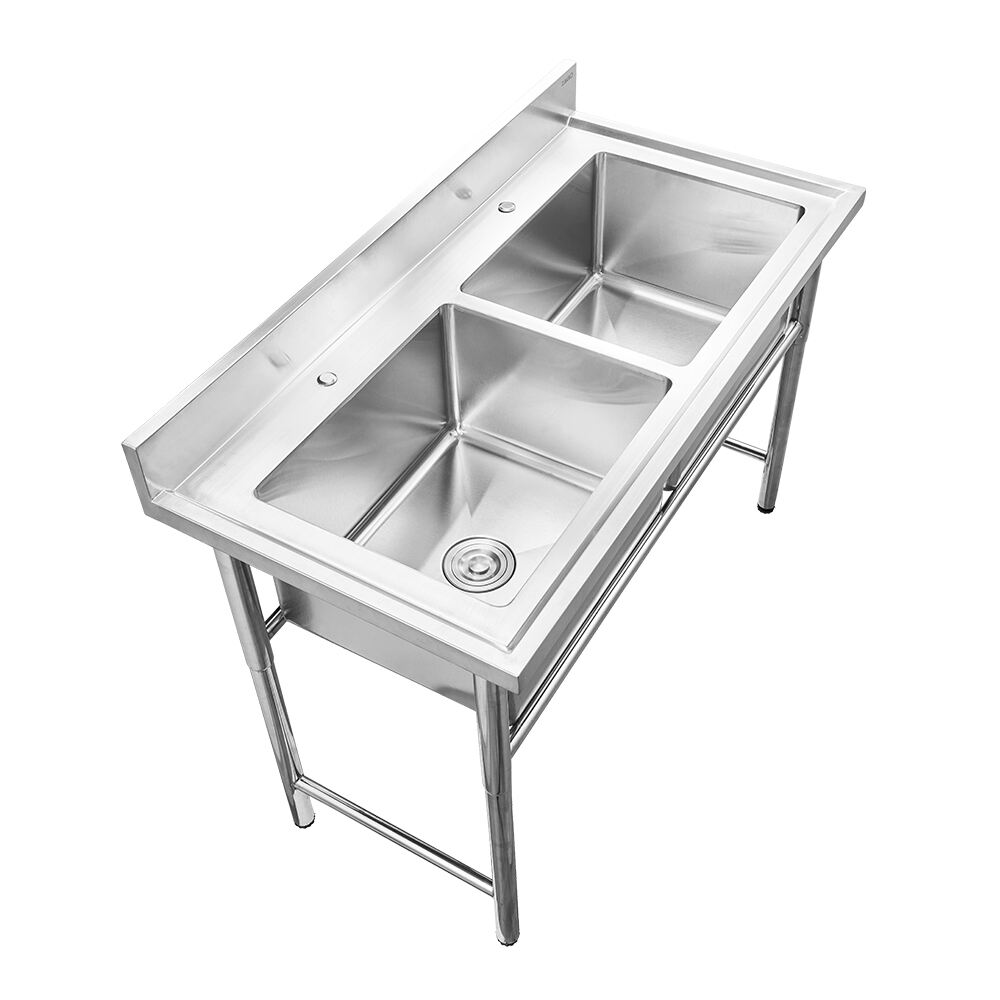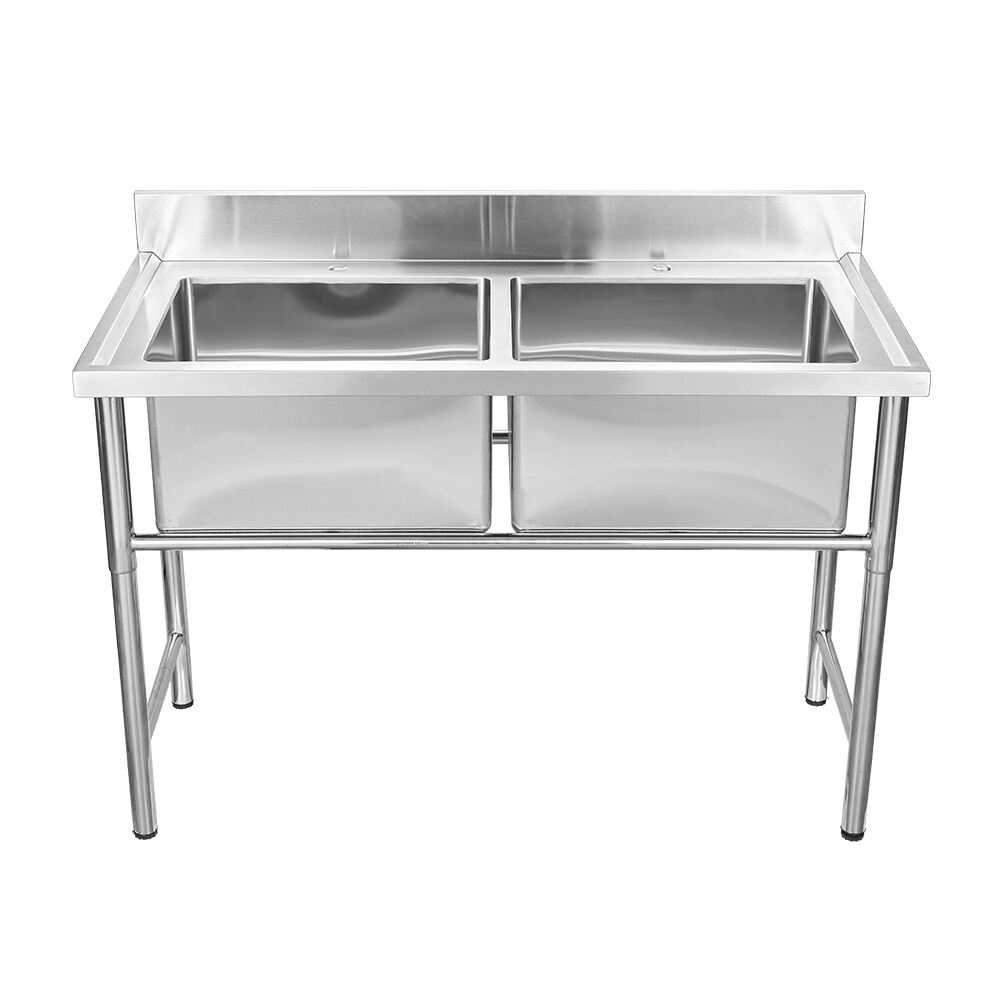Material Selection for Commercial Sink Durability
Stainless Steel Grades (304 vs 316 vs 201)
In considering materials for durability, the grades of stainless steel used to construct commercial sinks have a great influence on a sink's life span and resistance to corrosion. Grade 304 is an easy to clean, popular grade of stainless steel commonly used for general kitchen applications. Yet, over 70% of food service businesses prefer grade 304 because of its combination of strength and cost-effectiveness. In contrast, type 316 stainless steel incorporates molybdenum, which allows for the increased anti pitting and anti chloride ion corrosion properties. That makes it ideal for exposure to marine environments or chemicals. But it is more expensive than 304, which puts it out of the reach of many companies unless required by a specific environment.
Grade 201 stainless steel appears to be a more cost effective alternative the more expensive nickel-based counterparts because 201 contains higher amounts of manganese and nitrogen, replaced instead of nickel. Grade 201 is cheaper to produce and although it offers the corrosion resistance similar to the 300 series, it is predominantly used for industrial and not so harsh environments. Businesses should tack the initial capital investment requirements for higher grades to promote durability and efficiency in commercial sinks.
Composite Materials for Specialized Applications
Composite composites They have weight, appearance and strength in the traditional tai steel tank form not like others. These fixtures are made from the mixing of two or more components, developing a sink that is not just lightweight but also stands up to stains and scratches. This feature is especially important in specialized applications such as food service and medical facilities where clean, germ free surfaces are not just desired, but required. The non-porosity of composites makes them resistant to microorganism growth thus promoting hygiene and cleanliness.
From a practical standpoint, several of the standard types of sinks are being phased out of many commercial kitchens, which begin to melt some budgetary boundaries, while expecting a longer lifespan and less maintenance. You can read real-life testimonials from these companies that note huge savings and a certain degree of durability against the ravages of time. There are also environmental benefits of composites - many are 100% recyclable, consistent with sustainable trends in the sector. This flexibility and low environmental impact makes composites an attractive option for today's commercial environments that require unique sink solutions.
Impact of Material Thickness on Longevity
Wall thickness is one of the most important factors in engineering durability and lifetime of a commercial sink. Thick material provides better resistance for dents and holes perfectly ideal for high-traffic commercial kitchens. According to experts, the optimal thickness for most stainless steel sinks is 18-gauge or 20-gauge, though some sinks are available in 16-gauge or 14-gauge. Offers better protection in heavy or sharp environments.
According to research, thin gauge sinks tend to fail and repairs are quite expensive, so it’s important to consider the right specifications. Industry practice also promotes the use of thicker materials to address long-term decay, such as sagging from heavy use or material exposure to corrosive material. Material science experts in turn speculate that the future standard for material thickness will change in reaction to commercial demand, and become thicker to accommodate more eco-friendly and durable formulations that not only match consumers' needs today but what they will require in the future.
Space-Saving Designs for Compact Kitchen Layouts
Wall-Mounted Sink Benefits
Wall-hung sinks offer worthy option for tight kitchens. They help to save space on the floor and simplify cleaning under he sink area. These easy to use designs can be easily height adjusted for better ergonomics according to the need of any given user, especially useful in high-turnover commercial environments. This flexibility provides comfort and efficiency for kitchen workers, optimizing output. Wall-mounted sinks are also a visually-appealing trend with sleek, contemporary designs that fit right into the trendy kitchen of today. FLOOR MOUNTED OR WALL MOUNTED SINKS – Space saving design of commercial kitchen sinks improves working space and operation inside the kitchen worktables.
Corner Sink Installations
Corner bowl placements are an inventive way to use space in tight corners. These unique sink styles optimize features while saving counter space in the kitchen. They'll cause a large difference in work availability, appeal, and blocked availability in busy kitchens. Beautifully integrated corner sinks that follow the countertop, make for an overall streamlined interface and a great cooking experience as well! Statistics highlight how corner sinks have proved to be so effective in kitchen design in terms of maximization of space and the positive implications on an individual's ease of kitchen activity which leads to positive psychology.
Under-Counter vs. Drop-In Models
When comparing between them, you’ll want to consider the two problematic aspects that each type of sink will have on the installation process and aesthetics. Below counter models: Under-counter models give a contemporary or minimalist look, and are often chosen for their clean design, though they may be more difficult to fit. Drop-in speakers, however, are far simpler to install and easier to maintain, thanks to their flat fit. Both models impact kitchen design distinctively; under-counter sinks create more counter space across the board, while drop-in sinks can be more easily adjusted around existing counter structures. Some design professionals recommend under-counter mounting, as they say it goes with modern style better; however, commercial surveys have shown both preferences can vary by demographic to a certain extent based on market trends and other commercial factors.
High-Volume Performance Features
Optimal Basin Depth for Commercial Use
The depth of a sink basin is one of the most important factors in the overall efficiency of commercial sinks. Ideal basin depths are application-specific, but are typically designed in order to meet commercial requirements. Deeper bowls provide plenty of space for washing and cleaning. For example, a productivity study determined firms with sink bowl depths tailored for working conditions averaged a 20% improvement in washing efficiency. In addition, ergonomic studies indicate a correct-depth basin minimizes user fatigue and increases work flow comfort. Basin shall have a depth chosen for optimal performing with no excess water usage while also accommodating the ergonomics of the user providing practicality but not limit usability of will under heavy use.

Reinforced Construction Techniques
Sturdy commercial sinks include features such as double-walled construction and extra bracing that ensure long-lasting service. This extends the life of the sinks dramatically, saving the cost of numerous maintenance and replacement sink units. For commercial applications where saving time means saving money, these work horse models are guaranteed to be in demand and hard at work. Some, for instance, have seen meaningfully lower damage and failure incidents after having implemented double-walled sinks in their restaurants. Industry-standard and third-party testing reinforce the efficacy of these reinforcement methods and guarantee that the sinks can withstand the intense demands of daily commercial kitchen use while maintaining their strength.
Sloped Drainage for Efficient Cleaning
Reinforced Sloped Drainage – An integral part of almost any restaurant, bar, or food service is a quality sink with an efficient drainage system to avoid any standing water left behind. The inclined plane of the sink’s surface naturally facilitates the flow of water toward the drain, greatly reducing wash time and enhancing user experience in any busy commercial environment. With good draining system Grate design, water from the wet dish will simplify in to the sink, protect your kitchen counter from dampness and dirt. Lessons learned from sanitation experts suggest that enabling efficient flow at sinks can help avoid bottlenecks for cleaning. Research in industry also supports these findings, with potential cost savings related to better drainage systems, providing savings in labor and cleanliness in busy environments.
Maintenance and Cost-Efficiency Strategies
Daily Cleaning Protocols
Daily cleaning routines play a key role in keeping commercial sinks clean and in good condition for many years. Sinks come in variety of materials and are used for an array of purposes, and each requires specific cleaning solutions to avoid damage and function properly. For example, stainless steel sinks are best cleaned using a non-abrasive cleaner that doesn’t scratch, while natural stone sinks can benefit from pH-balanced solutions to avoid staining. Following manufacturer directions is not only important for the longevity of the sinks but also for preventing any warranty voids due to misuse. Health inspectors frequently narrate the petty failings of maintenance, like ignoring the under-sink area, where mold can flourish. Certain recommended products, such as mild cleanser for metal surfaces, or vinegar for the removal of lime deposits, can greatly help when cleaning on a daily basis.
Preventing Corrosion in Humid Environments
Keeping sinks from corroding in high humidity also requires strategic tactics like good ventilation and choosing the right building materials. Common materials are stainless steel or porcelain that resists rust and corrosion. High humidity is also a key factor in corrosion problems; in fact, research shows that maintenance for rust is higher in commercial kitchens with inadequate ventilation. Best practices, according to industry pros, involve installing dehumidifiers, making sure air circulates and applying protective coatings to sink surfaces. Furthermore, ISO type cleaning agents are also highly sought after as they have been found to reduce corrosion risk without compromising cleanliness.
Lifecycle Cost Analysis
"What is the lifecycle cost of a commercial sinks?" A lifecycle cost analysis of the various commercial sink types: A lifecycle cost of commercial sink helps you to know how much you would save over time with various types. Although cheap sinks might seem like a cost-effective solution when considering the low price tag, the longevity and low upkeep requirements of premium materials mean savings in the long term. Studies show that purchasing long lasting sinks can ensure a higher return on investment (ROI) than cheaper boxes that need to be replaced on a regular basis. These observations are parroted throughout discussion of commercial kitchen management when it comes to the fact that because a tough expenditure brings down both downtime and replacement intervals, the real beneficiary is one’s operating budget.
FAQ
Q: What are the benefits of using grade 316 stainless steel for commercial sinks?
A: Grade 316 stainless steel offers superior resistance to corrosion and pitting, making it ideal for environments exposed to harsh chemicals or marine conditions.
Q: Why might a business choose composite materials for their sinks?
A: Composite materials provide advantages such as lighter weight, enhanced stain resistance, and sustainability features, making them suitable for specialized applications requiring hygiene and efficiency.
Q: How does material thickness influence sink durability?
A: Thicker materials tend to resist physical impacts better, reducing damage like dents and scratches, which contributes to the longevity of commercial sinks.
Q: What are the benefits of wall-mounted sink designs?
A: Wall-mounted sinks save floor space, improve cleanliness, and offer customizable height options, enhancing ergonomics and productivity in compact kitchen layouts.
Q: How can slope drainage improve sink performance?
A: Sloped drainage minimizes water pooling, which expedites cleaning and enhances sanitation in high-use environments like commercial kitchens.



